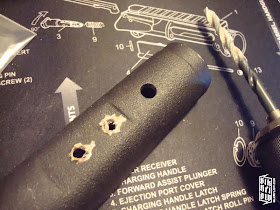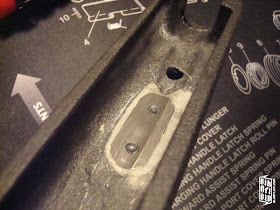I picked up another Sadlak accessory (this is where they get you!) for my trusty M1A, their front picatinny rail. I have a fiberglass stock and ordered accordingly. They have multiple options, not only based on stock type, but also have a front rail with or without a QD post. I chose the latter as I already have a QD adapter for my Harris bipod and hope to one day upgrade to a Bobro or Atlas.
The parts (pictured above) arrived with an instruction guide (not pictured). On the left, the front rail and, on the right, the oval nut plate with two socket head cap screws. The fiberglass stock on my M1A required significant fitting to accommodate the oval nut plate and, yeah, I probably took too much material off the inside of my stock, but I wanted to make damn sure that the plate, once permanently installed, would have zero interference with the op-rod.
This was an interesting install and goes in two phases; the first part is slow and methodical (mainly because of all the Dremeling to fit the oval nut plate), the second part, fast and concise. I mainly used tools that I had on hand, but did have to purchase a 9/32 drill bit from Home Depot for $4. Tools used for the install:
- 9/32 drill bit
- Dust mask, because you don't want to be inhaling fiberglass...
- Eye protection
- Painter's tape
- 5/32 hex key wrench
- JB Weld Metal Epoxy or equivalent
- Blue Loctite (pictured) or Red for permanence
- Dremel tool
- Dremel
1 1/2" cutting wheel (not pictured)
- Drill (not pictured)
- Vacuum cleaner with an extension wand or a portable handheld vacuum (not pictured)
First and foremost; safety, clear your firearm. Then disassemble your M1A, separating the stock and placing it in your work area. Please refer to my post on the
Sadlak NM Spring Guide install for the correct procedure.
[1] Remove Rivets Holding the Sling Plate
My SA Inc. M1A fiberglass stock had rivets, as seen above. I chose to grind off the rivets from the outside as access to the interior was very limited with the 1 1/2" Dremel cutting wheel. I did not worry about marring the sling swivel plate as it would be hidden beneath the rail (see 4th picture below).
Once I ground the rivets flush to the sling plate, I used a flat head screwdriver to pop off the plate. By doing this I noticeably bent the sling plate, d'oh! Not a problem, two pliers leveraged in the right position bent it back into place. The rivets were recessed and, although I wasn't concerned about marring the plate, I did not want to go too deep, thus the decision to pop off the sling plate with the rivets still partially intact.
[2] Resize Rivet Holes
Using the 9/32 drill bit, I enlarged the holes that previously held the rivets by drilling from the inside out. The bit sliced through the fiberglass with minimal applied force. The fiberglass did slightly crack on the exit holes, therefore I would recommend drilling from the exterior to the interior (opposite of what I did) for a possible cleaner cut. The interior area will have to be Dremeled out for the oval nut plate, so any split material will ultimately be removed. Once drilled, I checked the holes for fitment with the oval nut plate (as pictured below).
[3] Modify Stock For Oval Nut Plate Installation
While I had the oval nut plate temporarily placed to review the fit from the drilled holes in section 2, I applied some painter's tape around it as a basic guide. This is where you'll want to bring out your dust mask and vacuum cleaner as it is a process; slow and methodical, Dremeling out the area, stopping, vacuuming out the fiberglass dust, gauging the depth, placing the oval nut plate into position for fitment review, then back to Dremeling.
This part also took the longest to complete, close to 1/2 an hour on my end. I did not want to duff it up, but feel free to go faster. A
Dremel kit with a depth guide would have probably helped the process significantly, however, I do not know if the guide would fit on the interior of the stock. I did find a post on ARFCOM where someone did use one on his stock with success. Definitely an option to consider.
After the above photo was taken I removed the tape and Dremeled out the surrounding area to allow for additional JB Weld to be applied for the adequate bedding of the oval nut plate.
At some point I also decided to review my strategy and stopped to assess the step on the nut plate. I needed to remove more material, but I wanted to make it specific. I changed out the larger grinding bit with a smaller bit & proceeded to roughly grind out the area around the holes to accommodate the step on the nut plate.
As pictured above, fitment of the oval nut plate indicated I had reached the maximum depth, as any additional material removal would have resulted in the nut protruding from the base of the stock. This would not be desirable. Thus, Dremeling complete.
[4] Apply Epoxy & Work Fast!
After completing the Dremeling, I washed off the front-end of the stock to removed all the fiberglass dust. I toweled off the excess water and prepped for the final phase of the install. Get everything you need (5/32 hex key wrench and Loctite) within reach & ready to go, you will be working fast once the epoxy is mixed.
Pictured above is the mixed two part epoxy applied to the interior of the stock. I took small pieces, stuffed them into position, then cut out the excess where the holes were with an Exacto knife. I then pressed in the nut plate, as pictured below.
I then immediately attached the sling plate/rail combo via the two socket head cap screws, partially screwing them in by hand, then quickly applied Blue Loctite (in retrospect, I should have used Red) on the interior threads, finally proceeding to tighten them into place with the 5/32 hex key wrench.
At this point the epoxy has begun to set. I took a flathead screwdriver and chiseled off the excess epoxy before it had completely set. I did not do any additional sanding.
Final notes. I buggered up a few things on this install, thankfully nothing irreparable, but hopefully it helps you out and provides you with some necessary information to make the right decisions for your installation. In the end it came out perfectly fine and the rail feels extremely solid.
Lastly, Sadlak is no run-of-the-mill company that deals in cheap garbage generically labelled as "mil-spec", they set an American standard in quality, so no need to play marketing games or use (what has become) frivolous jargon. The parts I have received from them and the service thus far has been superior. Buy direct and support a fine American company! And another reason I suggest buying direct, if you have any questions what-so-ever, just give them a call and they will gladly help you out.













































